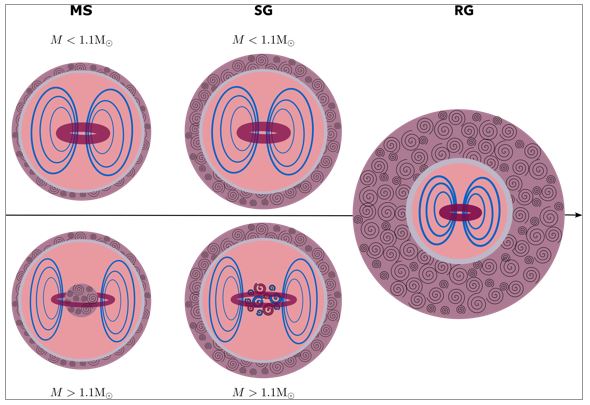An international collaboration led by a team from the Astrophysics Department/AIM Laboratory of IRFU has predicted and characterised the expected signature of internal magnetic fields in stars through their seismology - called asteroseismology. This study demonstrates that thanks to the very precise data from the Kepler (NASA), TESS (NASA) and soon PLATO (ESA) satellites, we are potentially able to detect magnetic fields in the cores of red giant stars (which are the descendants of low-mass stars such as our Sun and intermediate masses below ~8 solar masses). The results are published in two papers in the journal Astronomy & Astrophysics.
An international team including researchers from the Astrophysics Department (DAp) of CEA/Irfu, working in particular at the laboratory for the Dynamics of Stars, (Exo) planets and their Environment (LDE3), has been able to demonstrate that stars rotate faster than expected as they get older. Using asteroseismological techniques - the study of stars through the characterization of their oscillation modes by seismic methods - researchers were able to analyze for the first time a complete sample of 91 stars brooding ages 1 to 13 billion years. These data confirm that the oldest stars slow down their rotation less effectively. This discovery sheds new light on the evolution of star rotation and should make it possible to more accurately calculate the age of stars. These results are published in the journal Nature Astronomy on April 22, 2021.
The ancients understood that heroes, like Orion with Sirius, need their faithful companion. IRFU engineers and physicists and their collaborators are no exception to the rule and have just completed the development of a modern Sirius, a key element of the super spectrometer separator (S3) under construction at GANIL. The tests having been successful and the system has been moved to GANIL for its final installation.
In Greek mythology, Sirius, Orion's faithful four-legged companion, an outstanding hunter, was transformed into a constellation and placed at his side. This famous canid also gave its name to the brightest star in the night sky. IRFU physicists have just honoured him in their own way, this time in the world of detectors.




